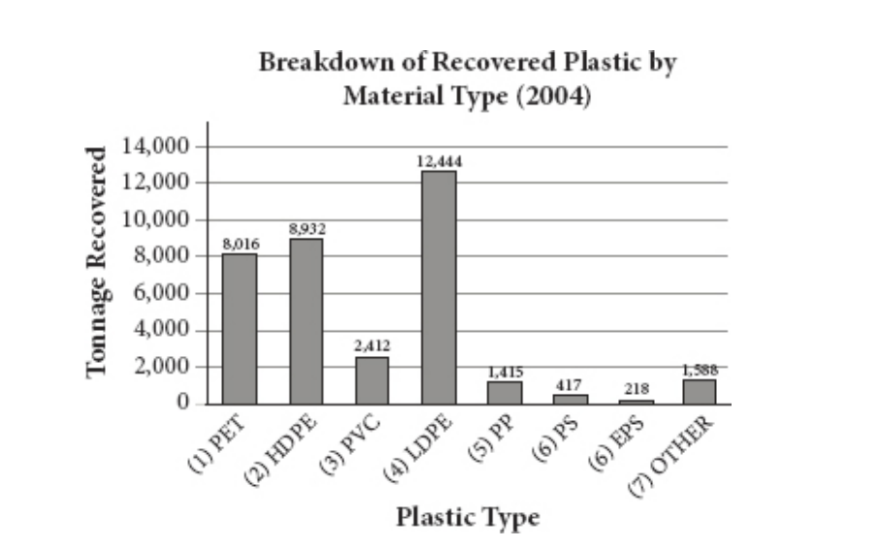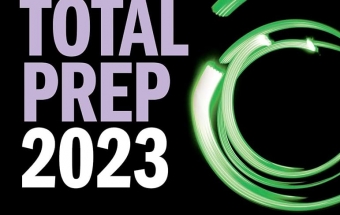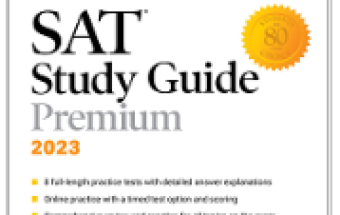SAT® Total Prep 2023 - Writing and Language Test
Questions 1–11 are based on the following passage and supplementary material.
Sorting Recyclables for Best Re-Use
From the time a plastic container is thrown into a recycling bin to the time the plastic 1 are actually recycled, it passes through several sorting cycles. In addition to being separated from the non-plastic items, the plastics themselves must be 2 detached, because not all plastics are alike, making some easier to recycle than others.
3 Special machines have been developed to assist in sorting plastics. During manual sorting, people 4 very thoroughly check the numbers on the bottom of each plastic item. The numbers indicate the type of plastic each is made from. Some sorting can be automated by using machines that can detect the composition of the plastic. The detectors in these machines use infrared light to characterize and sort the plastics, similar to how a human might use visible light to sort materials by their color. By either method, the plastics can eventually be arranged into bins or piles corresponding to the recycling code numbers running from one to seven.
In some cases, plastics are further sorted by the method by which they were manufactured. 5 However, 6 bottles, tubs and, trays are typically 7 made from either PET (polyethylene terephthalate) or HDPE (high density polyethylene), two of the least recovered plastics. Bottles are produced by a process called blow-molding, in which the plastic is heated until soft, then blown up, much like a balloon, while being pushed against a mold. Tubs and trays are usually made by a process called injection molding, in which the plastic is heated until it can be pushed through nozzles into a mold. Different additives are added to the plastics before 8 molding. It depends on the method. Since the additives for injection molding might not be suitable for blow-molding of the recycled plastic, PET and HDPE bottles are often separated out from the other PET and HDPE plastics.
While the numbers 1 through 6 indicate a 9 specific plastic, number 7 indicates that the plastic is either one of many other plastics, or that it is a blend of plastics. These plastics are more difficult to recycle, as different amounts of the various types of number 7 plastics will be sent to recycling each day. They are typically used for products in which the plastic will be mixed with other materials.
Although there are many types of plastics to be found in a typical recycling bin, each one can play a part in a recycled 10 product, the many cycles of sorting guarantee that each piece can be correctly processed and sent off for re-use. 11

1.
A) NO CHANGE
B) is
C) has been
D) will be
2.
A) NO CHANGE
B) demolished,
C) flanked,
D) categorized,
3. Which choice most effectively sets up the information that follows?
A) NO CHANGE
B) Sorting by hand is less efficient than using machines to sort plastics.
C) Classifying plastics can be done manually or by machines.
D) Plastics are widely used today, so they need to be recycled.
4.
A) NO CHANGE
B) completely and thoroughly check
C) thoroughly check
D) make sure to thoroughly check
5.
A) NO CHANGE
B) For example,
C) Consequently,
D) Similarly,
6.
A) NO CHANGE
B) bottles, tubs, and trays
C) bottles tubs, and trays,
D) bottles, tubs, and, trays
7. Which choice completes the sentence with accurate data based on the graphic?
A) NO CHANGE
B) made from PET (polyethylene terephthalate) or HDPE (high density polyethylene), the two most recovered plastics after the leading type, LDPE.
C) made from PP (polypropene) or PS (polystyrene), the two most recovered plastics after the leading type, PVC.
D) made from PP (polypropene) or PS (polystyrene), the two most recovered plastics after the leading type, EPS.
8. Which choice most effectively combines the sentences at the underlined portion?
A) molding, however, it depends
B) molding, depending
C) molding despite depending
D) molding, it depends
9.
A) NO CHANGE
B) vague
C) common
D) pending
10.
A) NO CHANGE
B) product the many
C) product. The many
D) product, so the many
11. Which choice most effectively establishes a concluding sentence for the paragraph?
A) Sorting ensures that plastics will not linger in the landfills, but continue to be of use.
B) Sorting different types of plastics is done in many ways, either by hand or machine.
C) Oftentimes, people are required to sort their own plastics by type.
D) There are many different kinds of plastics, and each one is useful.
Questions 12–22 are based on the following passage.
Interpreter at America’s Immigrant Gateway
12 Among the many diverse and fascinating possibilities for a career, David Kaufman chose language interpretation. Throughout his career as an interpreter at America’s largest immigrant-processing station, Kaufman has spent many ferry rides mentally preparing himself for the vivid realities of his job. Although some of his contemporaries might consider his work menial or inconsequential, he cherishes his opportunity to witness and contribute to the unfolding stories of countless immigrants. These immigrant stories, Kaufman knows, hold 13 great significance for his and American history. Most of the brave, sea-worn travelers who disembark at Ellis
Island will soon depart as new Americans, 14 lugging all there courage, hope, and worldly possessions into New York City. Many 15 will remain in the city and some other people will disperse across the nation.
[1] The year is 1907: the busiest year Kaufman, or Ellis Island, has seen. [2] One and a quarter million immigrants have been admitted to the U.S. this year. [3] Only about 2 percent of Ellis Island’s immigrantsare denied, typically for perceived potential criminal or public health threats. [4] The rest will establish life in America, although not without difficulty and perseverance. [5] At the immigration station, Kaufman regularly sees the range of raw human emotion, from deep, exhausted grief to powerful hope. [6] He has witnessed it all. 16
17 Many Ellis Island interpreters were born to European immigrants. 18 His heritage, and surrounding community, enabled him to learn six languages. Fluency in six languages is typical for Ellis Island interpreters, although Kaufman knows some who speak as many as twelve or thirteen. Kaufman knows that in some ways, his ability to listen and translate effectively can impact the course of an immigrant’s future. For this reason, he constantly hones his language skills, picking up various 19 shades and dialects in hopes to better
help those he serves. Kaufman assists colleagues at every checkpoint. Ellis Island is
equipped with a hospital, dining room, and boarding room, in addition to the more central processing facilities.
20 Kaufman is one of an army of Ellis Island employees spread around the enormous compound. This morning, he helps an Italian family discuss their
child’s health with nurses. Later, he translates for a Polish woman who expects to meet her brother soon. When Kaufman meets immigrants whose language he cannot speak, he finds another interpreter 21 to help speak to them instead of him doing it.
To some extent, Kaufman sees himself distinctly in the shoes of these immigrants. He intimately knows the reality that almost all Americans, somewhere in their ancestry, were not native to this nation. With every encounter, Kaufman hopes that these immigrants will soon find whatever they crossed oceans to seek. He hopes, as he still does for his own family, that life in America will someday render the 22 advantages of leaving home worthwhile.
12. Which choice provides the most appropriate introduction to the passage?
A) NO CHANGE
B) Many people never consider language interpretation as a job, but David Kaufman knows all about it.
C) All jobs come with difficulties, and David Kaufman believes language interpretation is no different.
D) A pale horizon meets the early-morning sky as David Kaufman’s commuter ferry crosses the New York Harbor, bound for
13.
A) NO CHANGE
B) great significance for his—and America’s—history.
C) great significance for his: and America’s history.
D) great significance for his, and America’s, history. Island.
14.
A) NO CHANGE
B) lugging all they’re courage,
C) lugging all their courage,
D) lugging all there are courage,
15.
A) NO CHANGE
B) will remain in the city, but other people will nonetheless disperse across the nation.
C) will remain in the city; many others will disperse across the nation.
D) will remain in the city, though yet others will disperse across the nation.
16. Sentence 1 should be placed
A) where it is now.
B) after sentence 2.
C) after sentence 3.
D) after sentence 4.
17. Which sentence most effectively establishes the central idea of the paragraph?
A) NO CHANGE
B) Like many Ellis Island interpreters, Kaufman was born to European immigrants.
C) Language ability was especially important among Ellis Island interpreters.
D) Some accused children of European immigrants of having an unfair advantage in getting jobs at Ellis Island.
18.
A) NO CHANGE
B) His heritage, and surrounding community enabled him to learn six languages.
C) His heritage and surrounding community, enabled him to learn six languages.
D) His heritage and surrounding community enabled him to learn six languages.
19.
A) NO CHANGE
B) meanings
C) tricks
D) nuances
20. Which sentence best supports the central idea of the paragraph?
A) NO CHANGE
B) From medical screening to records confirmation to inspection, Kaufman interprets as needs arise.
C) Sometimes, Kaufman feels the stress of being pulled in many different directions, but ultimately he finds his job worthwhile.
D) Kaufman and his colleagues work, eat, and practically live together, making them feel closer than typical coworkers.
21.
A) NO CHANGE
B) to help speak instead of him.
C) helping him out with speaking.
D) to help.
22.
A) NO CHANGE
B) journeys
C) difficulties
D) penalties
Questions 23–33 are based on the following passage.
Software Sales: A Gratifying Career
Ever since she was a young girl, Stephanie Morales took on the role of family problem solver. 23 She remembers her brother never being able to find his favorite movie when he wanted to watch it: So, she alphabetized the family DVD collection. 24 “They’re about efficiency and what makes sense to a user,” Morales says, “and putting systems in place so that using something becomes effortless.”
Growing up, Morales became notorious among her friends as the one to plan parties and trips, and she was always voted team captain because everyone knew she could see the big picture and enact a plan. 25 After college, she tried a career in interior design, but homes and offices didn’t excite her. “I didn’t have a passion for furniture or architecture. I knew there must be a field out there that really tapped into my particular skill set,” Morales says.
[1] To her surprise, that career turned out to be software consulting. [2] Morales returned from a backpacking trip around Europe to her parents’ New Hampshire home, needing income. [3] New Hampshire also has many fine backpacking trails. [4] 26 Although she had no direct experience in the field, Morales convinced a family friend to hire her as a software consultant to work with new clients. 28 She had helped many of her friends with their computers. Knowing her interpersonal skills were strong.
29 Because she was willing to work in a factory, she was able to achieve success as a consultant. For example, Morales worked witha manufacturing company that was growing quickly but had trouble 30 maintaining employees. The company’s human resources department could not keep up with regular payroll and billing, plus running advertisements and interviewing potential replacement employees. Morales used staff management software to gather data about employee satisfaction. Analysis showed that employees found the shift work too challenging for their schedules. The company changed the hours of the morning and evening shifts to meet employees’ needs, which led to fewer workers leaving the company.
Nowadays, Morales works with what she calls “big data,” such as information about consumer habits gathered through a supermarket membership card. These stores of information are a treasure trove to Morales, because they tell the story of how people interact with the world around them. She uses the data to make changes—just like alphabetizing a DVD collection. Her goal is to 31 vacillate into the health care field, where she wants to bring the benefits of technology to people’s physical and mental well-being. 32 For example, Morales is also interested in whether people pay for their medications with credit or debit cards. Morales knows that people’s health is extremely important, and every time someone fills a prescription online or has a follow-up visit with their doctor, that information helps medical experts better determine efficacy of the medication. The technological revolution has the power 33 to quicken doctor’s visits, improve the care we get, and even save lives.
23. A) NO CHANGE
B) She remembers her brother never being able to find his favorite movie, when he wanted to watch it so she alphabetized the family DVD collection.
C) She remembers her brother never being able to find his favorite movie; when he wanted to watch it, so she alphabetized the family DVD collection.
D) She remembers her brother never being able to find his favorite movie when he wanted to watch it, so she alphabetized the family DVD collection.
23.
A) NO CHANGE
B) She remembers her brother never being able to find his favorite movie, when he wanted to watch it so she alphabetized the family DVD collection.
C) She remembers her brother never being able to find his favorite movie; when he wanted to watch it, so she alphabetized the family DVD collection.
D) She remembers her brother never being able to find his favorite movie when he wanted to watch it, so she alphabetized the family DVD collection.
24.
A) NO CHANGE
B) It’s
C) Their
D) Its
25.
A) NO CHANGE
B) After college, she tried a career in interior design: but homes and offices, didn’t excite her.
C) After college, she tried a career in interior design—but homes, and offices didn’t excite her.
D) After college she tried a career, in interior design; but homes and offices didn’t excite her.
26.
A) NO CHANGE
B) Although she had no direct experience in the field, Morales convinces
C) Although she has no direct experience in the field, Morales convinced
D) Although she will have no direct experience in the field, Morales convinces
27. Which sentence does not support the paragraph’s topic and purpose?
A) Sentence 1
B) Sentence 2
C) Sentence 3
D) Sentence 4
28.
A) NO CHANGE
B) She had helped many of her friends; with their computers and she knew her interpersonal skills were strong.
C) She had helped many of her friends with their computers; knowing her interpersonal skills were strong.
D) She had helped many of her friends with their computers, and she knew her interpersonal skills were strong.
29. Which choice most logically introduces the paragraph?
A) NO CHANGE
B) Morales’s management of data led to the success of the company’s advertising campaign.
C) Where the job really matched up with her strengths was in problem-solving and finding creative solutions.
D) Morales’s advice to the human resources department resulted in higher wages for employees.
30.
A) NO CHANGE
B) retaining
C) containing
D) detaining
31.
A) NO CHANGE
B) convert
C) transition
D) fluctuate
32. Which choice best supports the topic sentence of theparagraph?
A) NO CHANGE
B) For example, Morales spends countless hours walking through discount stores surveying the customers.
C) For example, Morales still gets great satisfaction from organizing her friends’ and family’s DVD collections.
D) For example, Morales can use “big data” to determine how many patients from a particular clinic use online automated refills.
33.
A) NO CHANGE
B) to quicken doctor’s visits improve the care we get, and even save lives.
C) to quicken doctor’s visits, improve the care we get, and even, save lives.
D) to quicken doctor’s visits; improve the care we get, and even save lives
Questions 34–44 are based on the following passage.
The Art of Collecting
At an art exhibition for artist Henri Matisse, enthusiasts can also view a black-and-white photograph of two siblings. These sisters,
wearing Victorian-style dresses and top hats, are the renowned art collectors Claribel and Etta Cone. When Etta passed away in 1949, she 34 bequeathed some 3,000 objects to the Baltimore Museum of Art (BMA). Now, works from the Cone Collection, internationally renowned and consisting of masterpieces by early 20th-century artists, travel on loan from BMA so that people can experience the Cone sisters’ visionary passion for and dedication to modern art.
35 Henri Matisse was a well-known supporter of female artists and art patrons, and he revealed these unconventional attitudes in his work. What made the Cone sisters innovative was their recognition of the value of art pieces by virtually unknown avant-garde artists of their time, such as Pablo Picasso. Critics failed to understand the Cones’ 36 tastes and such opinions did not squelch the sisters’ passion for collecting. According to Katy Rothkopf, senior curator at the BMA, Matisse’s use of vibrant color, for example, was initially shocking. “At first the Cones . . . really found [the art] quite scary,” states Rothkopf. However, the siblings befriended Matisse and other artists, gaining respect for the painters’ unorthodox experimentation. As the Cones began buying and collecting art, 37 there selections improved.
“It took a lot of gall—guts—to paint it,” Matisse once said about a controversial painting, “but much more to buy it.” Claribel and Etta had that kind of gall. 38 Each had took risks by not purchasing traditional landscape paintings and instead amassing works that at the time were considered contemptuous and wild.
[1] A further legacy of the Cone Collection was its documentation of post-World War I Europe. [2] The art the Cones collected 39
suggested changes in Europe, such as the increasing use of machines in contemporary life and the emergence of modern
thinking. [3] Traditional limitations in art were overcome by experimental forms and new media, allowing artists to explore their
creativity. [4] Today, there are even more experimental forms of art than there were after World War I. 40
41 Additionally in visiting Paris, Budapest, Athens, Cairo, and Shanghai, the Cones represented the beginning of the new woman at the turn of the century. 42 Though their unconventional lifestyle, the far-seeing Cone sisters experienced freedom from narrower roles. They avoided the gross inequalities between genders by becoming connoisseurs of radical art. 43
Public acceptance of the 44 Cone’s avant-garde collection testifies to their accomplishments. While the estimated value of their artwork is one billion dollars, their larger contribution is inestimable. As bold patrons, the Cones advanced appreciation for modern art for generations to come.
34.
A) NO CHANGE
B) liquidated
C) delivered
D) allotted
35. Which choice best establishes the central idea of the paragraph?
A) NO CHANGE
B) Together the Cones, supported by the wealth from their family’s textile business, gathered one of the finest collections of French art in the United States.
C) The Cones became great contributors to the Baltimore Museum of Art, and their renowned exhibition was praised by artists around the globe.
D) During this time period, only the wealthy could afford to purchase original artworks, and the Cones became famous for spending their entire fortune on art.
36.
A) NO CHANGE
B) tastes, so such opinions
C) tastes therefore such opinions
D) tastes, but such opinions
37.
A) NO CHANGE
B) they’re
C) their
D) her
38.
A) NO CHANGE
B) They took risks
C) They have taken risks
D) Each will take risks
39.
A) NO CHANGE
B) depicted
C) referenced
D) divulged
40. Which sentence should be deleted to best maintain the theme of the paragraph?
A) Sentence 1
B) Sentence 2
C) Sentence 3
D) Sentence 4
41.
A) NO CHANGE
B) Additionally, in visiting: Paris,
C) Additionally, in visiting Paris,
D) Additionally in visiting Paris
42.
A) NO CHANGE
B) Therefore
C) Thorough
D) Through
43. What changes to the paragraph would best strengthen the author’s claims?
A) The author should define the terms “new woman” and “narrower roles.”
B) The author should list more nations and cities visited by the Cone sisters.
C) The precise centuries referenced by “turn of the century” should be included.
D) The author should add reactions from contemporary critics to the Cones’ travels.
44.
A) NO CHANGE
B) Cones’
C) Cones
D) Cones’s









